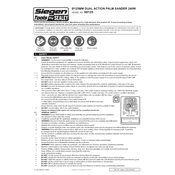Sealey S0125 Instruction Manual


To change the sanding disc, first ensure the sander is unplugged. Press the spindle lock button and rotate the sanding pad by hand until it locks. Use a wrench to unscrew the pad nut, remove the old disc, place the new disc, and retighten the nut securely.
Begin by selecting the appropriate grit size for the task. Start with a coarser grit for initial smoothing and switch to a finer grit for finishing. Move the sander in a uniform pattern and apply light pressure to avoid gouging.
Check the power cord and plug for any damage. Ensure the outlet is functional by testing with another device. Examine the power switch for any blockages or damage. If the sander still does not start, consult a professional technician.
Regularly clean the sander by wiping it down and blowing out dust from vents. Inspect the sanding pad and replace it if worn. Check the power cord for wear and tear. Lubricate moving parts as per the manufacturer's instructions.
Attach a vacuum hose to the dust extraction port on the sander. Use sanding discs with dust extraction holes to improve efficiency. Consider using a dust collection bag or system to minimize airborne particles.
Ensure that the sanding disc is properly attached and not worn or damaged. Check for any debris or obstructions on the pad. If the issue persists, inspect the motor bearings or consult a service technician.
Yes, the Sealey S0125 Sander can be used for metal surfaces, but ensure to use the correct type of abrasive disc designed for metal sanding. Always start with a finer grit and work gradually to avoid overheating the metal.
Store the sander in a cool, dry place away from direct sunlight. Ensure it is clean and the power cord is coiled neatly. Keep it in its original case or a protective bag to prevent dust accumulation and damage.
Start with a coarse grit to level any rough surfaces, then progress to medium and fine grits for smoothing. Use consistent, even pressure and overlapping strokes. Finish with a very fine grit for the best results.
Always wear protective eyewear and a dust mask. Ensure the work area is well-ventilated. Avoid loose clothing and jewelry that could get caught in the sander. Keep hands away from the moving parts and unplug the sander when changing discs.